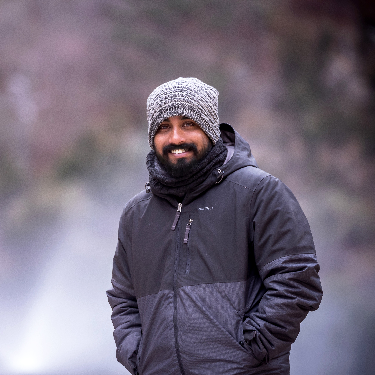Nithin Divakar
Phd Scholar
Amphibians and bats have fascinated me since my childhood with their nocturnal life. The curiosity for understanding their life and interactions with the surrounding environment inculcated in me a keen interest in learning community ecology and also how these communities vary across the changing geographical conditions. After completing my Masters in Wildlife Studies in 2015, I actively contributed to the on-ground conservation of bats and amphibians in the Kerala part of Western Ghats through conservation research and stakeholder involvement. Following my interest and passion for both the taxa, I focused mainly on species-specific activities including the long term conservation management of threatened species like Latidens salimalii, Walkerana phrynoderma, Nasikabatrachus sahyadrensis in their distributional ranges. In this journey, I was fortunate to get support from the Mohamed Bin Zayed Species Conservation Fund & Idea Wild grant for the conservation of lesser-known endangered Malabar torrent toad and the Conservation Leadership Programme grant for the conservation of endangered Salim Ali’s fruit bat in 2021 . I strongly believe that conservation of a landscape or a species is connected with the involvement of communities living there and hope I can build a network there with research and conservation education which will equip both the groups.
Publications:
Ravishankar, C., Ravindran, R., John, A. A., Divakar, N., Chandy, G., Joshi, V., & S. M. Goyal. 2022. Detection of Newcastle disease virus and assessment of associated relative risk in backyard and commercial poultry in Kerala, India. Veterinary Medicine and Science, 8(3), 1146-1156. DOI: https://doi.org/10.1002/vms3.747
Divakar, N., M.B. Paul, A.S. Madhu & K. Chandran. 2021. Conservation challenges: saving the Salim Ali’s Fruit Bat one step at a time. Small Mammal Mail #435, In: Zoo’s Print 36(5): 01–04.Wayanad in the Western Ghats of Kerala, India.” Journal of Threatened Taxa, 10(8), 12103-12107. Journal
Ramvilas, G., Dhyani, S., Kumar, B., Sinha, N., Raghavan, R., Selvaraj, G., Divakar, N., Anoop, V.K., Shalu, K., Sinha, A., Das, S., Kulkarni, A., & S. Molur. 2021. Insights on COVID-19 impacts, challenges and opportunities for India's biodiversity research: From complexity to building adaptations. Biological conservation, 255, 109003. DOI: 10.1016/j.biocon.2021.109003
Das, S., Syed, E. P., Divakar, N., Thomas, A., & Tapley, B. (2021). Predators of an evolutionarily distinct and globally endangered Frog Nasikabatrachus sahyadrensis Biju and Bossuyt, 2003. Herpetology Notes, 14, 247-249.
Roshnath, R., & Divakar, N. (2019). Solving species quandary: why awareness programs are pivotal in snake conservation. Herpetological Journal, 29(4). DOI: 10.33256/hj29.4.214218
Das, S., Tapley, B., Gray, C. L., Das, J. P., & Divakar, N. (2018). Purple frog, Nasikabatrachus sahyadrensis, in Kerala, India. An output from the EDGE of Existence fellowship, Zoological Society of London.
Kanagavel, A., Parvathy, S., Nirmal, N., Divakar, N., & Raghavan, R. (2017). Do frogs really eat cardamom? Understanding the myth of crop damage by amphibians in the Western Ghats, India. Ambio, 46(6), 695-705. DOI: 10.1007/s13280-017-0908-8
Kanagavel, A., Parvathy, S., & Divakar, N. (2017). Education workshops improve the ability of forest departments to identify amphibians in Western Ghats, India. Conservation Evidence, 14, 21.
Roshnath, R., Basheer, A., & Divakar, N. (2015). Rescued Spectacled Cobra Naja naja eggs hatched in captivity. Newsletter of the South Asian Reptile Network, 17, 30.
Roshnath, R., Divakar, N., Chandran, K., Valsarajn, D., & Jose, A. (2014). Heronry census, 2014 in Kannur district, Kerala. Malabar Trogon, 12, 9-13.
